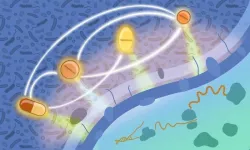(Press-News.org) A woman’s fertility normally decreases by her late 30s with reproductive function eventually ceasing at menopause. It is known that a small molecule called nicotinamide adenine dinucleotide (NAD+) plays a critical role in this decline, and Buck scientists have revealed how this happens and have identified potential new approaches to enhance reproductive longevity.
“Studying ovarian biology and reproductive aging is not just about trying to increase fertility, but really about the overall health of females,” said Buck President and Chief Executive Officer Eric Verdin, MD, senior author of the study, which is in iScience, published by Cell press. “We want to understand the processes that lead to decreased fertility that are linked to menopause and therefore linked to overall lifespan and healthspan of women. This is a perspective shift that needs to happen.”
“We really made a step forward in understanding the role of NAD in ovarian function and how a female’s reproductive lifespan progresses,” said Rosalba Perrone, PhD, co-first author of the study and a senior research scientist in the Verdin lab. “What makes this research exciting is demonstrating we can modulate NAD+ to affect fertility.”
NAD+, which is present in all cells throughout the human body, begins to decline with age and maintaining optimal levels is vital for key cellular functions and healthy aging, said Perrone. Recently, it became clear that the same decline was occurring in the ovaries, contributing to the natural winnowing over time of egg numbers combined with reduced egg quality, both of which contribute to decreased fertility in females.
“So we knew that NAD was really important in promoting ovarian function, but what we didn’t know is why it declines in the first place, what is the driver of this decline?” she said.
To uncover the molecular mechanisms regulating ovarian NAD+ loss, first the researchers began by adding another piece of the puzzle: CD38, an enzyme known to be one of the main culprits in degrading NAD+.
What happens during aging, Perrone explained, is that more CD38 is expressed, leading to more degradation of NAD+, which accelerates the aging processes. However, CD38’s role in female reproductive function was not established. “We realized nobody had even looked at where this protein was located in the ovaries, so we really started from scratch,” she said.
The team found that CD38 was primarily found in ovarian immune cells and located in specific structures outside the ovarian follicles.
“We also saw that CD38 increases with age within the ovaries, which is the first time this has been shown,” she said, noting that the more CD38 was present, the less NAD+ there was. “Discovering the missing link in the literature, showing that CD38 expression led to NAD+ decline, was the most exciting part.”
Additionally, the team investigated a type of mouse that completely lacks CD38 and found that mice without CD38 have more “primordial follicles” which eventually mature to release an egg. Females are born with a finite number of such follicles which determine the length of the ovarian lifespan, and therefore the fertility of an individual. “We were amazed to see that the increased number of primordial follicles was associated with more offspring, reinforcing the biological relevance of our observations,” she said.
Showing that CD38 regulates ovarian function and fertility through NAD+ metabolism means that targeting this molecule may offer new approaches to enhance reproductive longevity.
“CD38 absolutely is a druggable target,” said Perrone, noting that there are a number of small molecules and antibodies already available that specifically recognize CD38’s ability to degrade NAD+. “What made this research rewarding is knowing that we can potentially modulate how CD38 consumes NAD+ and increase fertility when conception is desired.”
While this work builds a comprehensive picture of CD38’s role in consuming NAD+ and affecting fertility, Perrone emphasizes that this work reaches far beyond fertility.
“We know that menopause, which we commonly associate with loss of reproductive potential, is actually linked to overall lifespan and healthspan,” she said. “So understanding what makes our reproductive organs work better is really important to study the aging process in general, and in particular for women.”
CITATION: CD38 regulates ovarian function and fecundity via NAD+ metabolism - ScienceDirect
[Volume 26, Issue 10, 20 October 2023, 107949]
DOI: https://doi.org/10.1016/j.isci.2023.107949
Other Buck researchers involved in the study include co-first authors Prasanna Vadhana Ashok Kumaar and Lauren Haky, as well as Cosmo Hahn, Rebeccah Riley, Julia Balough, Giuliana Zaza, Bikem Soygur, Kaitlyn Hung, Leandro Prado, Herbert G. Kasler, Ritesh Tiwari, Hiroyuki Matsui, Genesis Vega Hormazabal, and Francesca E. Duncan; as well as Indra Heckenbach and Morten Scheibye-Knudsen, Center for Healthy Aging, University of Copenhagen, Denmark
Acknowledgements: This study was supported by the Bia-Echo Foundation, the Sergey Brin Family Foundation and the Buck Institute for Research on Aging institutional funding.
COI: Verdin is a scientific co-founder, shareholder, and advisor of Napa Therapeutics, Ltd. Verdin, Perrone, and Kumaar receive research support from Napa Therapeutics, Ltd.
About the Buck Institute:
The Buck’s success will ultimately change healthcare. The Buck Institute for Research on Aging aims to end the threat of age-related diseases for this and future generations by bringing together the most capable and passionate scientists from a broad range of disciplines to identify and impede the ways in which we age. An independent, nonprofit institution, its goal is to increase human healthspan, or the healthy years of life. Globally recognized as the pioneer and leader in efforts to target aging, the number one risk factor for serious chronic diseases including Alzheimer’s, Parkinson’s, cancer, macular degeneration, atherosclerosis (heart attack and stroke), and type 2 diabetes, the Buck wants to help people live better longer.
END
Researchers uncover mechanism that links NAD+ to fertility problems
More than a fertility study, the findings from the Buck Institute can help understand female aging in general
2023-10-18
ELSE PRESS RELEASES FROM THIS DATE:
Study elucidates evolution of mosquitoes and their hosts
2023-10-18
Researchers at North Carolina State University and global collaborators have mapped the mosquito’s tree of life, a major step toward understanding important traits, such as how the insects choose their hosts, feed on blood and spread disease. The findings will help researchers make better predictions to model disease transmission and understand what makes some mosquitoes better disease carriers than others.
The research suggests that mosquito evolution over the past 200 million years mirrors the Earth’s ...
Fighting antimicrobial resistance with new drug combinations
2023-10-18
Antimicrobial resistance – occurring when pathogens can survive antibiotic treatment – is one of the most rapidly emerging global public health threats today. According to a 2022 study, nearly five million deaths were associated with antibiotic-resistant bacteria in 2019, with over a million deaths per year directly attributable to antimicrobial resistance.
In a new study, researchers from the Typas Group at EMBL Heidelberg have systematically profiled over 10,000 drug combinations for their effectiveness against common multidrug-resistant bacteria.
“Previously, ...
New model provides window into Alzheimer’s disease development
2023-10-18
GRAND RAPIDS, Mich. (Oct. 18, 2023) — A new model developed by Van Andel Institute, Lund University and University of Florence scientists will enable researchers to better understand how Alzheimer’s disease progresses in the brain.
Like other neurodegenerative diseases, Alzheimer’s is challenging to study. It is immensely complex, develops over a long period of time and varies from person to person. Critically, scientists also lack non-invasive techniques to monitor disease progression in the human brain. Instead, they often rely on models that mimic the disease, allowing them to ...
Trends, outcomes of assisted reproductive technology cycles using a gestational carrier
2023-10-18
About The Study: There was an increased likelihood of live birth among assisted reproductive technology cycles with a gestational carrier versus those without a gestational carrier in this analysis of 2014 to 2020 national surveillance data. Gestational carrier use was a risk factor for twins, even after adjusting for the number of embryos transferred. More than one-quarter of embryo transfers to gestational carriers involved two or more embryos despite national recommendations of single embryo transfer.
Authors: Lisa M. Shandley, M.D, M.Sc., of the Emory University School of Medicine in Atlanta, is the corresponding author.
To access ...
Over $3.7 million in NIH grants will fund research on impacts of climate change on HIV-related health outcomes
2023-10-18
New York, NY | October 18, 2023 – Two grants from the National Institute of Allergies and Infectious Diseases (NIAID), a four-year $3.2 million award and a 12-month $550,000 administrative supplement, will support innovative research to advance the understanding of how climate change and extreme weather influence HIV-related health outcomes around the world.
A multidisciplinary team of researchers from the CUNY Institute for Implementation Science in Population Health (CUNY ISPH) at the CUNY Graduate School of ...
Clinical Quality Registries revolutionize clinical research and healthcare in Intensive Care Units
2023-10-18
Recently published in the scientific journal Critical Care Medicine, a review led by the D’Or Institute for Research and Education (IDOR) shed light on the importance of clinical quality registries (CQRs) for the healthcare sector. Also known as electronic medical records, CQRs are systems for collecting and storing health information related to patients and their treatments. The publication includes the collaboration of 15 countries' institutions and shows how the qualified collection of clinical and administrative information has been relevant for optimizing healthcare and management in intensive care units ...
Researchers developing ‘revolutionary’ multi-material for light-based 3D printing
2023-10-18
AMES, Iowa – The U.S. National Science Foundation (NSF) is looking for materials that “revolutionize and engineer our future.”
Researchers at Iowa State University and the University of California, Santa Barbara think they can do just that by fundamentally changing Digital Light Processing – a type of 3D printing that users light rather than heat to quickly cure and harden liquid resin into plastic layers – to enable multi-material printing.
“We want to produce two material properties ...
New institute aims to address gap in nation’s health care system through highly effective yet overlooked nutrition interventions
2023-10-18
A newly launched, first-of-its-kind institute aims to address a glaring gap in the medical system by working to integrate food-based nutrition interventions into health care to treat disease and advance health equity.
The Food is Medicine Institute at the Friedman School of Nutrition Science and Policy at Tufts University, launched today, establishes a university-wide initiative aimed at transforming health care through scalable food-based interventions such as: medically tailored meals and prescriptions for produce; nutrition education for doctors; and clinical care, electronic health record, and reimbursement pathways for nutrition-based tools to help treat or prevent ...
Wyss Institute at Harvard University wins BARDA contract to leverage human Organ Chips to advance knowledge and drug-discovery for broad range of health security threats
2023-10-18
By Benjamin Boettner
(BOSTON) — The Biomedical Advanced Research and Development Authority (BARDA), part of the Administration for Strategic Preparedness and Response (ASPR) at the U.S. Department of Health and Human Services (HHS), partnered with the Wyss Institute at Harvard University to support the Institute in advancing its human Organ Chip platform and drug discovery capabilities to better understand the illness and injuries that result from a broad range of health security threats, including high doses of radiation, as well as predicting and evaluating ...
Google Quantum AI and Stanford University researchers use measurements to generate quantum entanglement and teleportation
2023-10-18
Quantum mechanics is full of weird phenomena, but perhaps none as weird as the role measurement plays in the theory. Since a measurement tends to destroy the “quantumness” of a system, it seems to be the mysterious link between the quantum and classical world. And in a large system of quantum bits of information, known as “qubits,” the effect of measurements can induce dramatically new behavior, even driving the emergence of entirely new phases of quantum information.
This happens when two competing effects come to a head: interactions and measurement. In a quantum system, when the qubits interact ...
LAST 30 PRESS RELEASES:
Cuffless blood pressure technologies in wearable devices show promise to transform care
AI-based tool predicts future cardiovascular events in patients with angina
Researchers map how the cerebellum builds its connections with the rest of the brain during early development
Routine scans could detect early prostate radiotherapy changes
Fairness in AI: Study shows central role of human decision-making
Pandemic ‘beneath the surface’ has been quietly wiping out sea urchins around the world
Tea linked to stronger bones in older women, while coffee may pose risks
School feeding programs lead to modest but meaningful results
Researchers develop AI Tool to identify undiagnosed Alzheimer's cases while reducing disparities
Seaweed based carbon catalyst offers metal free solution for removing antibiotics from water
Simple organic additive supercharges UV treatment of “forever chemical” PFOA
£13m NHS bill for ‘mismanagement’ of menstrual bleeds
The Lancet Psychiatry: Slow tapering plus therapy most effective strategy for stopping antidepressants, finds major meta-analysis
Body image issues in adolescence linked to depression in adulthood
Child sexual exploitation and abuse online surges amid rapid tech change; new tool for preventing abuse unveiled for path forward
Dragon-slaying saints performed green-fingered medieval miracles, new study reveals
New research identifies shared genetic factors between addiction and educational attainment
Epilepsy can lead to earlier deaths in people with intellectual disabilities, study shows
Global study suggests the underlying problems of ECT patients are often ignored
Mapping ‘dark’ regions of the genome illuminates how cells respond to their environment
ECOG-ACRIN and Caris Life Sciences unveil first findings from a multi-year collaboration to advance AI-powered multimodal tools for breast cancer recurrence risk stratification
Satellite data helps UNM researchers map massive rupture of 2025 Myanmar earthquake
Twisting Spins: Florida State University researchers explore chemical boundaries to create new magnetic material
Mayo Clinic researchers find new hope for toughest myeloma through off-the-shelf immunotherapy
Cell-free DNA Could Detect Adverse Events from Immunotherapy
American College of Cardiology announces Fuster Prevention Forum
AAN issues new guideline for the management of functional seizures
Could GLP-1 drugs affect risk of epilepsy for people with diabetes?
New circoviruses discovered in pilot whales and orcas from the North Atlantic
Study finds increase in risk of binge drinking among 12th graders who use 2 or more cannabis products
[Press-News.org] Researchers uncover mechanism that links NAD+ to fertility problemsMore than a fertility study, the findings from the Buck Institute can help understand female aging in general




